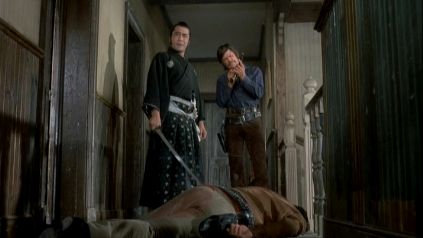« Trumpets, Westbound | Main | Coffee Break »
May 14, 2009
Red Sun

Terence Young - 1971
Evergreen Entertainment All Region DVD
Seeing Red Sun almost thirty-seven years after its U.S. released, my thoughts are almost the same as when I first saw this film. The casting of Charles Bronson, Toshiro Mifune and Alain Delon seemed to offer so much promise. And while Red Sun is fairly entertaining, this more literal melding of the western with the samurai film falls short, perhaps needing the visual dynamics offered by Sergio Leone or even John Sturges.
Taking place in 1870, Bronson and Delon lead a gang of train robbers who find the Japanese ambassador in a private car. Delon takes a specially designed sword, a gift to the President, for himself. One of the ambassador's samurai escorts is shot down by Delon. The other samurai, Mifune, promises to track down Delon and recover the sword in a week's time. Meanwhile, Delon has also turned around to ambush Bronson, leaving him behind while he and the gang run off with their loot. Bronson and Mifune form an uneasy alliance, tracking down Delon for their own reasons, gradually, and sometimes grudgingly, developing mutual respect.

One of the four writers credited for the screenplay was William Roberts, the man responsible for envisioning an Akira Kurosawa film with a motley band of cowboys instead of ronin. One of the Magnificent Seven was Charles Bronson. One of the other writers, Denne Bart Petitclerc, wrote the pilot for the television series, Then Came Bronson, pretty much suggesting that his participation in this film was someone's idea of a joke. Writer Lawrence Roman's best known film is McQ, the John Sturges directed attempt to re-invent an aging John Wayne in the mold of Clint Eastwood's character, "Dirty Harry". And Eastwood became an international star taking on the role originally done by Toshiro Mifune in another samurai film by Akira Kurosawa. One of Delon's most noted roles was as star in Le Samourai. Red Sun, to a certain degree, reflects some of the cultural give and take of that time between filmmakers.
As has been widely repeated, Red Sun was a hit almost everywhere except the United States. Toshiro Mifune and Alain Delon had already cemented their status as cinematic icons of Japan and France, respectively. Charles Bronson was still a couple of years from realizing major stardom in Death Wish. Red Sun also proved to be the last starring role for Ursula Andress, almost appropriately guided by the director of her first starring role in Dr. No. Maybe it was the heavily accented English that got in the way for most U.S. viewers. Mifune and Bronson's scenes are the best in part because they were unafraid of having their characters look foolish. Delon, in contrast, never looks like he's comfortable away from his more usual urban surroundings. As the prostitute Delon loves, Andress displays just enough skin to titillate the teenage boys in the audience, but she has often been an aloof presence on screen. Mifune's direction seems to have been to "play the gruff samurai", but he's game enough to be caught in his fundoshi, taking a cold water bath outdoors, and getting caught without his clothes or his sword by Bronson. Bronson, in turn, sees his abilities at bare knuckle brawling reduced to being Mifune's oversized rag doll, an introduction to Japanese martial arts consisting of Bronson tossed several times to the ground. Especially as Charles Bronson allowed himself to be typecast as a humorless agent of vengeance following the later films after Death Wish, Red Sun is one of the few times to see Bronson's comic side.
Terence Young probably got the job as director as he was Bronson's favorite director at the time. Too often, there are shots of the sun, sometimes with filters, as if Young, or his screenwriters, felt the intense need to justify the title of the film. There are enough scenes taking place in the desert to convey the heat and dust where much of the action takes place. The most visually interesting work is in the last twenty minutes when all of the principle characters converge. Especially striking is Bronson and Mifune barely seen, hiding in tall wheat, staking out the rendezvous point. Red Sun came at a time when interest in Italian westerns had tapered off. Somewhere, there must be some interesting stories regarding the making of, what on the surface, was a great idea for a film. Even if Red Sun isn't the film one might imagine, in no way does it diminish its team of legendary stars.

Red Sun is available from HK Flix
Posted by Peter Nellhaus at May 14, 2009 12:15 AM
